‘I treat them like pets’: The world of Singapore’s carnivorous plant lovers
From Little Shop Of Horrors to Mario Bros’ Piranha plants, carnivorous plants such as the Venus flytrap are the stuff of pop culture nightmares. But for some, they’re family.
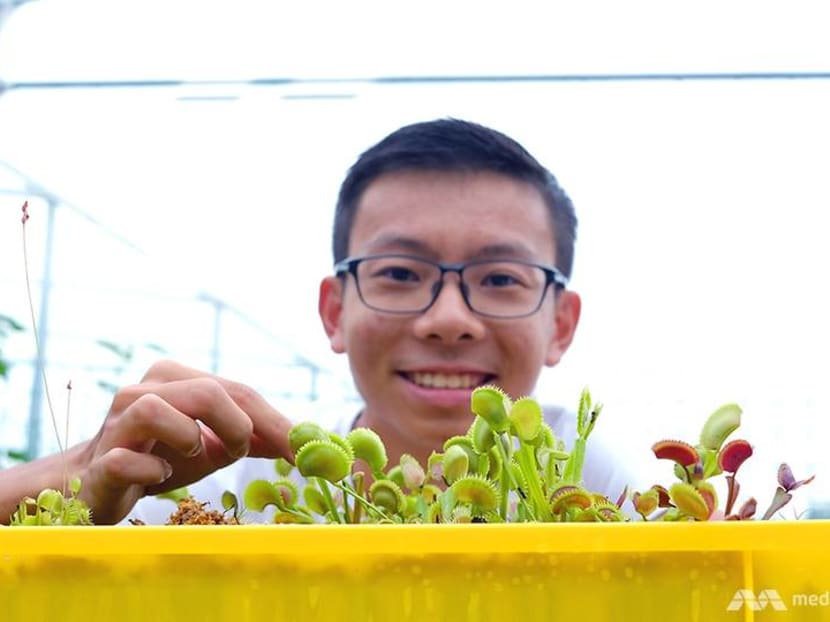
SG VenusFlytrap group's Darren Ng with some of his "pets". (Photo: Joyee Koo)
There’s a community garden at Punggol that looks just like any other garden where people come to grow their plants in peace. But if you happen to be a housefly, it’s the ultimate garden from hell.
Look closer and you’ll see planters full of Venus flytraps, many of which still have insect carcasses trapped within those creepy little jaws of theirs. They come in different colours and have names straight out of horror movies: Polish Dracula, Red Piranha, Big Mouth, Maroon Monster.
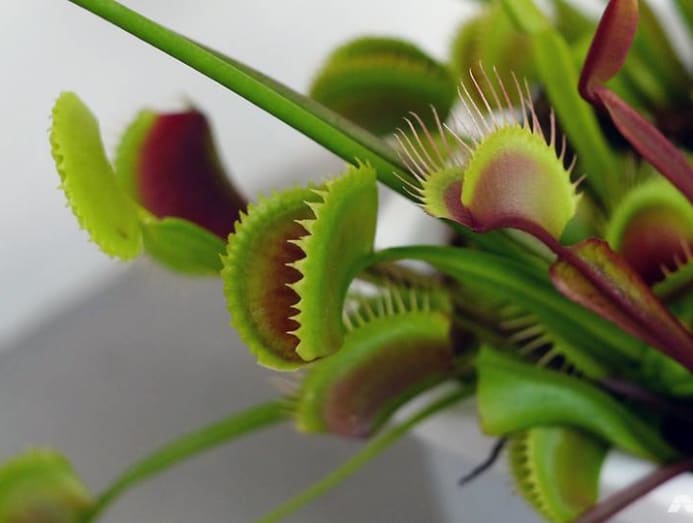
“At first, I didn’t think highly of plants – they were always eaten by animals and insects, or people just stepped on them. Later, I found out that, hey, some of them could actually bite back!” quipped Darren Ng.
FROM VENUS FLYTRAPS TO PITCHER PLANTS
The 20-year-old Ng is the founder of SG VenusFlytrap, a group dedicated primarily to these unusual plants. What began as a Facebook group four years ago has now evolved to include a website and, much to many an insect’s dismay, the six-month-old garden at Tebing Lane.
The group also sells plants, and organises workshops, talks and even the odd carnivorous plant-themed children’s birthday party. “They got to have a hands-on experience feeding the plants,” shared Ng.
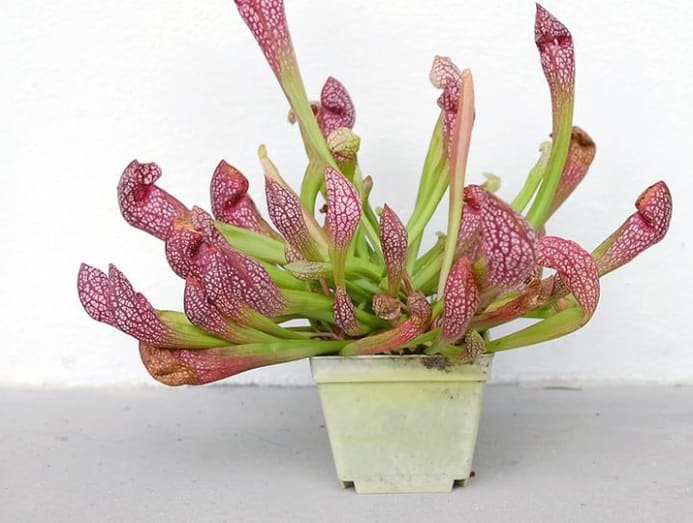
While majority of people consider carnivorous plants as the stuff of nightmares or just weird oddities thanks to movies and games like Little Shop Of Horrors and Mario Bros, Ng and his friends belong to a small but active online community in Singapore who obsess over the real deal.
Facebook groups such as SG VenusFlytrap and Carnivorous Plants Singapore have been popular places for enthusiasts to share photos and trade info about their flytraps, pitcher plants and sundews.
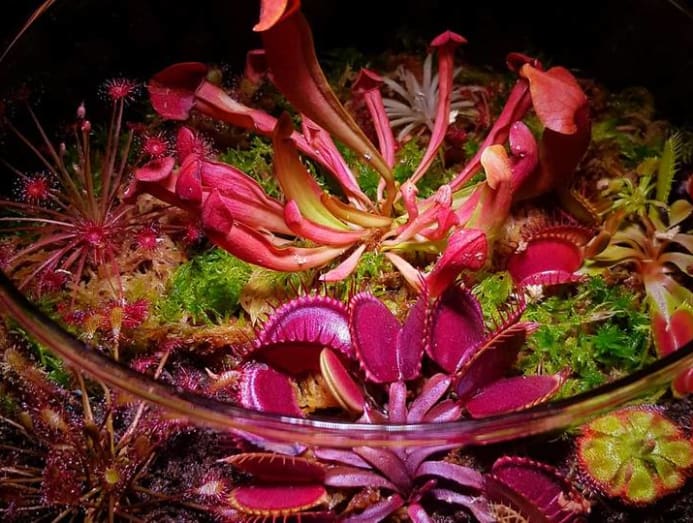
Carnivorous plants also recently had their day in the sun – the recently concluded Singapore Garden Festival Horticultural Show at the new Jurong Lake Gardens included it as one of the categories in a new competition.
READ: 10 indoor plants that will flourish despite small spaces and low light
Although considered a niche hobby, the number of people getting into carnivorous plants have grown been growing, said Cindy Chiang, one of the Facebook admins for Carnivorous Plants Singapore. “I do see requests to join (our group) every day, and there have been a lot more this year and last year in particular,” observed the 46-year-old primary school teacher, who has also written a book on carnivorous plants.
BIG ENOUGH TO EAT RATS?
So just what types of people are attracted to these kinds of plants? According to Chiang, it’s a pretty varied group. “You can find lawyers, I know of one guy who’s an entrepreneur. There are people who are vegetarians but actually enjoy how plants capture and digest their food – and some will even try their best to save the insects. And then there’s the other extreme, of people buying because of the thrill of seeing an insect caught and digested,” she said.
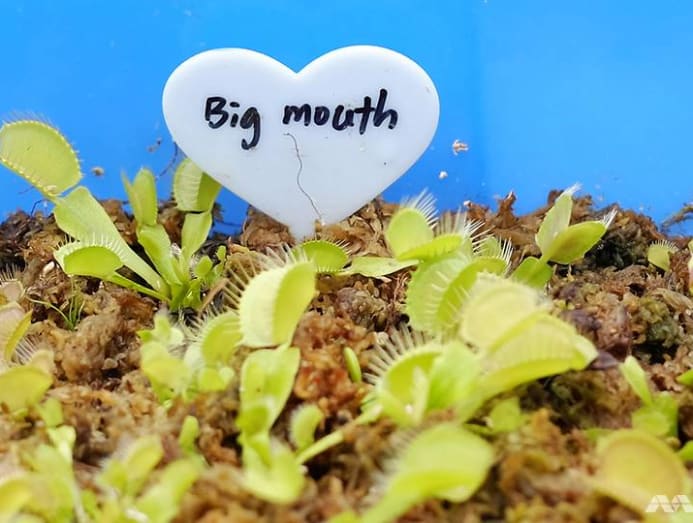
In Chiang’s case, the attraction started after hearing stories as a child of how her grandfather had actually kept these at home. “My father said they’d be big enough to eat rats! I got hooked and when I was in my twenties, that’s when I bought my first Venus flytrap,” she said, adding that her current collection of carnivorous plants number about 200 to 300 pots.
For collector and seller Tan Li Hui, it was a trip to a big flower market in Taiwan that got her hooked. “I had already grown flower plants and fruit trees before and when I saw a sundew, I thought it was so unique,” said the 50-year-old former computer programmer.
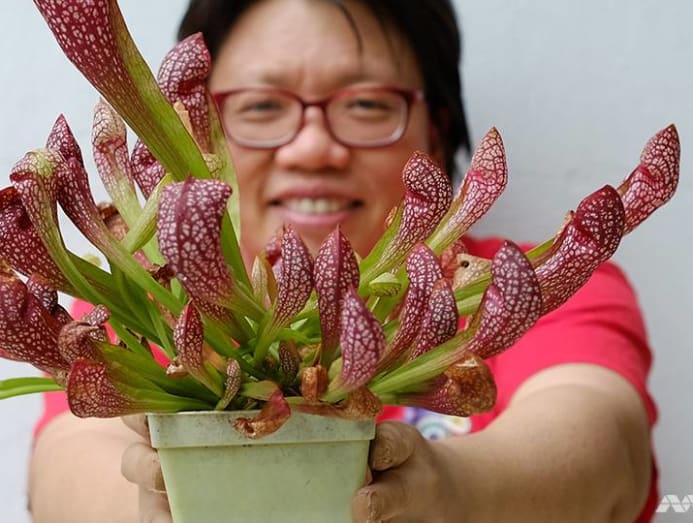
Today, Tan’s collection runs “in the thousands” and four years ago, she decided to start selling some of these online and once a month at Hort Park.
As for Ng, it took a while to be open about his hobby during his Secondary School days. “I didn’t want to share it with my friends because I was scared of being called the weird plant guy,” he said, until his biology teacher encouraged him to continue his pursuits and he found out a lot of his fellow students were also curious about carnivorous plants.
FEEDING THEM FISH FOOD
While growing carnivorous plants have become somewhat trendy, it can be a challenge in Singapore’s tropical climate, too, since many species are from temperate climates and can be high-maintenance. And there’s a bit of paperwork involved as well.
While there are a few carnivorous plants found in Singapore – usually around MacRitchie Reservoir and Kent Ridge Park – many plants are sourced from overseas such as Europe and Australia and require certification, said Tan.
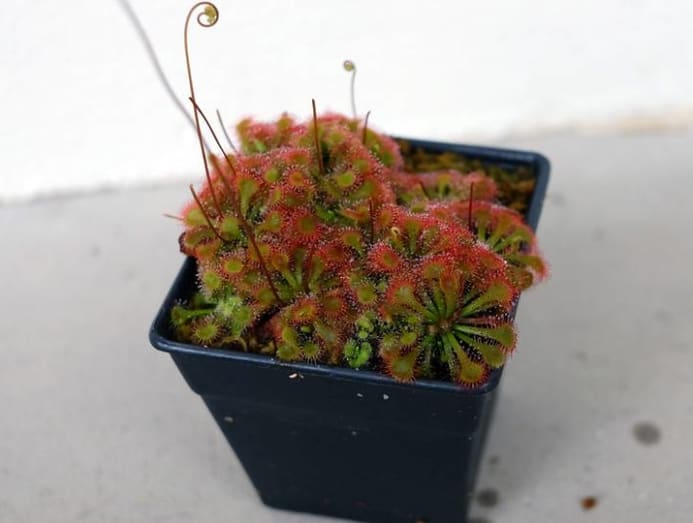
You need to be patient, too. “It’s not like flowering plants where you throw a sunflower seed in soil and it’s flowering like crazy after three months. You’re talking about months or years, sometimes,” she added.
Ng reckons one reason it remains a niche hobby is that imported plants don’t do well in the long term in Singapore, thanks to the weather. “So many people end up killing them,” he said.
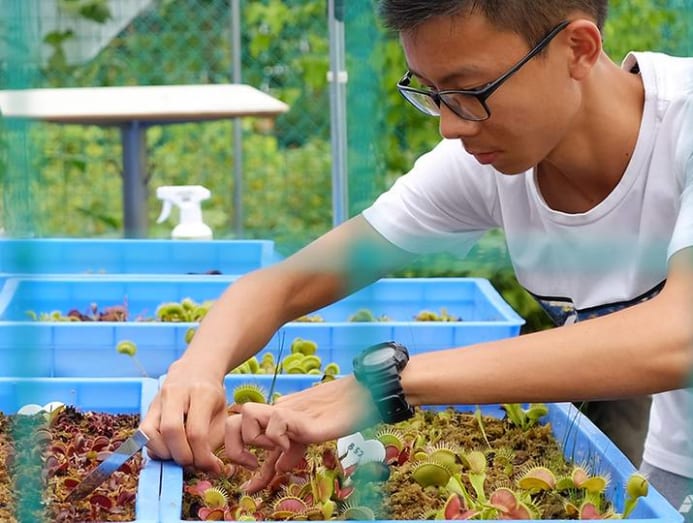
For his part, Ng has been playing the role of amateur scientist, experimenting with how to make Venus flytraps, which are particularly delicate and sensitive to climate conditions, thrive better in tropical conditions.
In fact, Chiang pointed out that Singapore is slowly becoming a hub for carnivorous plants because of this. “Our temperature is hot and warm 365 days and we don’t have winter or spring, so a lot of international growers take a look at how we grow them here – setting up aquariums, putting them inside airconditioned rooms,” she said.
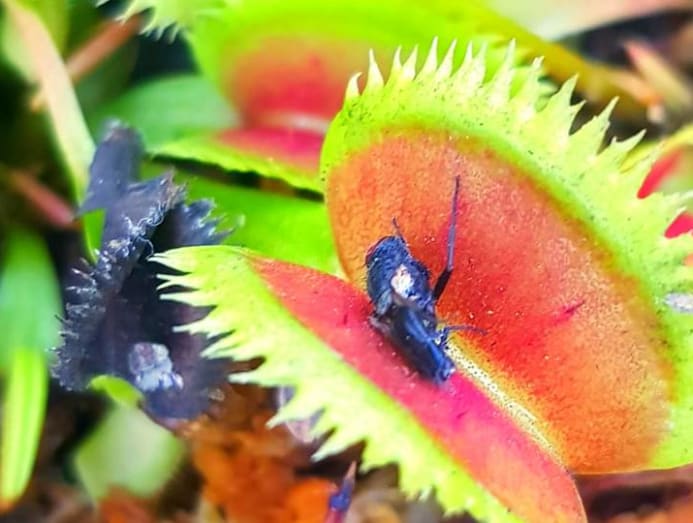
Finally, there’s the matter of feeding them. While the ideal situation is to let them capture their prey naturally, it can be an issue for those living in flats, especially those higher up, where there typically aren’t a lot of insects. Instead, they’re fed fish pellets soaked in water – or not at all.
“A lot of people have the misconception that they survive solely on insects, but they get their main source of energy from the sun. Catching insects is a supplement to them, and even if they don’t eat, they’ll grow,” said Ng.
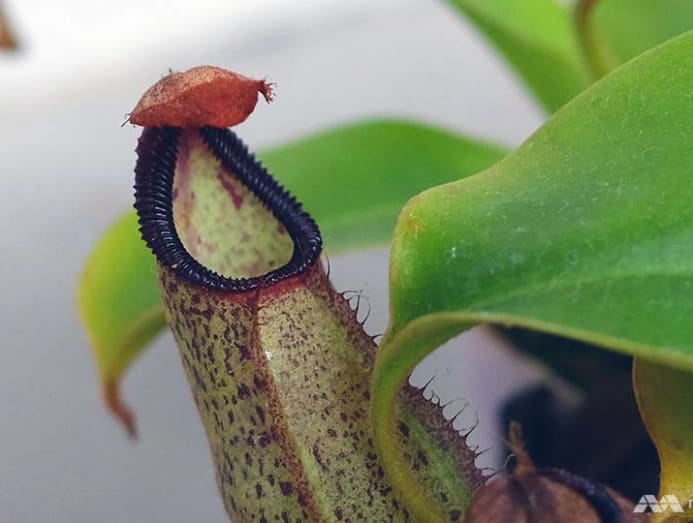
Of course, there are inevitable moments when you find out your plant has captured an animal – which includes not just bees, wasps, flying ants but even lizards. “I have a lot of lizards accidentally falling into pitcher plants or my flytraps would catch them, too. It can stink!” said Tan.
BEAUTIFUL EVEN WITHOUT FLOWERS
But all these, of course, are what makes growing carnivorous plants a unique hobby. And the payoffs aren’t just because of their hunter-like nature but also because they can just be as beautiful even without the flowers.
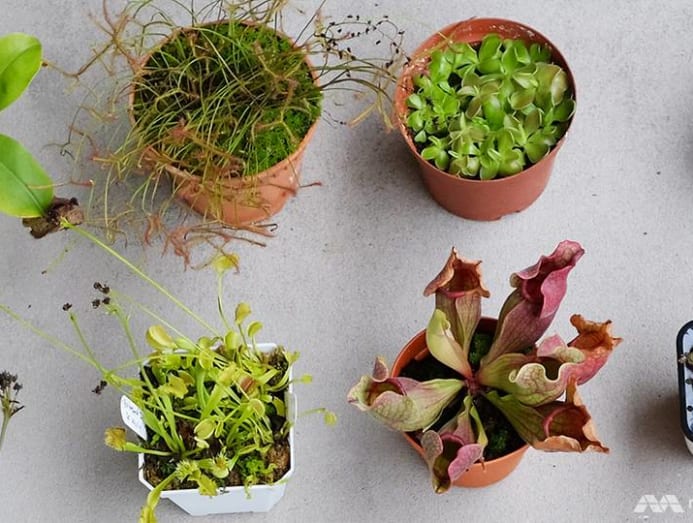
“Even without flowering, the plants have these beautiful, attractive colours. They could be red, purple, yellow,” said Ng, who incidentally won for his own pitcher plants and sundews at the SGF Horticultural Show. (There wasn’t any category for his favourites, Venus flytraps.)
Added Chiang: “If you’re growing a pitcher plant, as long as the conditions are met, every leaf will give you a pitcher, compared to if you’re growing ornamental plants where you may not have flowers all the time.”
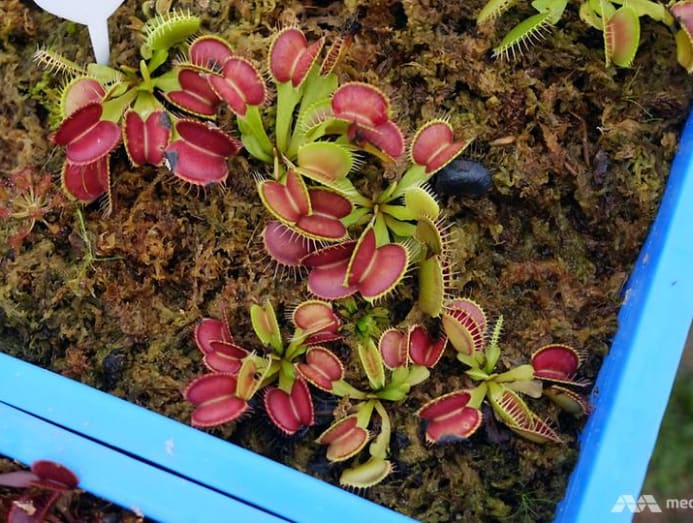
But perhaps the biggest perks to owning and taking care of one is the fact that, well, it’s like having a plant and a pet at the same time.
“Yes, I sometimes treat them like pets and call them my babies,” said Tan, with a laugh. “Don’t you think they’re cute?”





